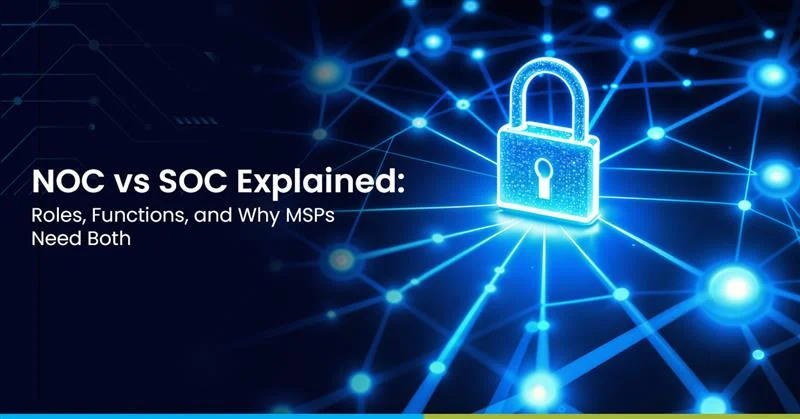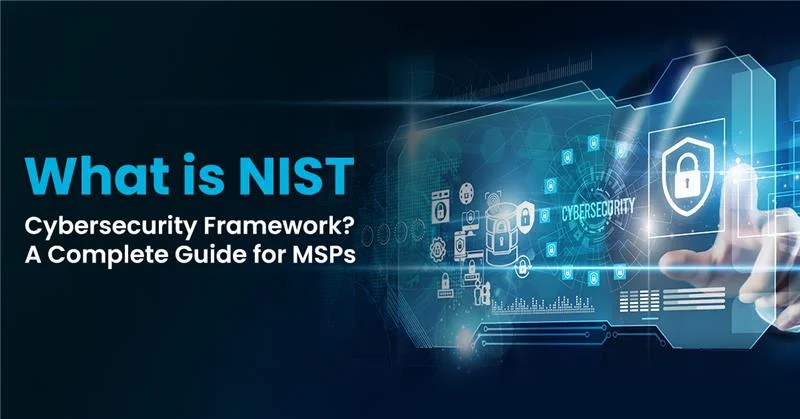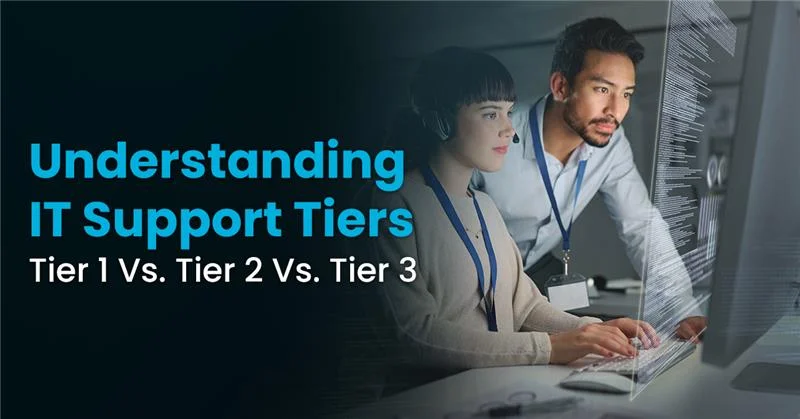Ever wondered why some MSPs win enterprise contracts while others struggle to get past basic service inquiries? The secret often lies in understanding a fundamental distinction that separates amateur providers from industry leaders: NOC vs. SOC operations.
Most MSPs think they can handle everything with a single “monitoring team.” This approach works fine until a major client asks pointed questions about your network operations center capabilities versus your security operations center protocols. Suddenly, that oversimplified structure becomes a competitive liability.
The confusion between these operations centers costs businesses dearly. Data breaches now average $4.88 million (IBM 2024), while downtime exceeds $300,000 per hour for 90% of enterprises (ITIC 2024). Getting NOC services for MSP along with SOC services roles wrong could mean the difference between rapid resolution and catastrophic losses.
Let’s cut through the confusion and explore why successful MSPs need both operations centers working in harmony.
What is a NOC? Understanding Network Operations Center
Think of your network ops center as the air traffic control tower for your digital infrastructure. While pilots (your applications) fly around, the NOC ensures safe takeoffs, landings, and smooth flights without collisions.
NOC definition and core purpose
A network ops center serves as the nerve center for monitoring, managing, and maintaining your clients’ IT infrastructure. The NOC vs. SOC distinction starts here—while security focuses on threats, the network ops center focuses on performance, availability, and connectivity.
Your NOC team’s primary mission? Keep the lights on. They monitor everything from server performance to bandwidth utilization, ensuring your clients’ networks run smoothly 24/7/365.
Key NOC functions and responsibilities
The network ops center handles several critical functions:
- Real-time network monitoring across all client environments
- Performance optimization to prevent slowdowns before they impact users
- Incident escalation procedures when issues exceed predefined thresholds
- Infrastructure maintenance coordination including patches and updates
- Capacity planning to prevent resource exhaustion
Real-World Scenario: Last month, I watched our network ops center detect unusual CPU spikes across a client’s server farm at 3 AM. Instead of waiting for morning complaints, our NOC team automatically triggered load balancing and alerted the client’s IT manager. Result? Zero downtime and a very happy client who never knew there was almost a problem.
What is a SOC? Understanding Security Operations Center
If your NOC is the air traffic controller, your SOC is airport security—always watching for threats, analyzing suspicious behavior, and responding when danger appears.
SOC definition and security focus
A Security Operations Center specializes in cybersecurity monitoring, threat detection, and incident response. The NOC vs. SOC comparison becomes clear here: while your network ops center keeps systems running, your SOC keeps them safe from attackers.
Think of your SOC as your digital bodyguard service. They’re not worried about whether emails are flowing smoothly—they’re concerned about whether those emails contain malware targeting your client’s executives.
Essential SOC functions and capabilities
Your SOC team focuses on several specialized areas:
- Security event monitoring using SIEM platforms and threat intelligence
- Incident response and forensics when breaches occur
- Vulnerability management to patch security holes before exploitation
- Compliance monitoring ensuring clients meet regulatory requirements
- Threat hunting to find advanced persistent threats hiding in networks
Real-World Scenario: I’ll never forget when our SOC team detected unusual network traffic patterns at one of our manufacturing clients, suggesting data exfiltration. While our network ops center showed normal performance metrics, our SOC analysts discovered an advanced persistent threat that had been quietly stealing intellectual property for months. Our quick action prevented an estimated $3.2 million in IP theft.
NOC vs. SOC: Key differences explained
Understanding NOC vs. SOC differences isn’t academic—it directly impacts how you staff, tool, and structure your operations to serve clients effectively.
Primary Focus: Network Performance vs. Security Threats
The fundamental NOC vs. SOC distinction lies in their priorities:
NOC priorities:
- Network availability and uptime
- Performance optimization
- Infrastructure stability
- User connectivity experience
SOC priorities:
- Threat detection and prevention
- Incident response and containment
- Risk assessment and mitigation
- Compliance and regulatory adherence
Tools and Technologies: NOC vs. SOC Comparison
Your network ops center and SOC require completely different technological ecosystems:
Network Operations Center tools:
- Network monitoring platforms (SolarWinds, PRTG, Nagios)
- Performance analytics and reporting dashboards
- SNMP monitoring and alerting systems
- Infrastructure management platforms
SOC tools:
- SIEM platforms (Splunk, QRadar, ArcSight)
- Threat intelligence feeds and analysis tools
- Forensics and incident response platforms
- Vulnerability scanners and management systems
Skill Sets and Expertise Requirements
The people powering your NOC vs. SOC operations need vastly different expertise:
Network ops center specialists need:
- Network engineering and infrastructure knowledge
- Performance tuning and optimization skills
- Hardware troubleshooting capabilities
- System administration experience
SOC analysts require:
- Cybersecurity and threat analysis expertise
- Incident response and forensics training
- Compliance and risk management knowledge
- Threat hunting and investigation skills
NOC Vs. SOC Real-World Challenge:
We learned this lesson the hard way when we tried to save costs by having our network ops center team handle basic security monitoring. When a sophisticated ransomware attack hit one of our clients, our team spent precious hours figuring out forensics procedures instead of containing the threat. That expensive mistake taught us that NOC vs. SOC expertise isn’t interchangeable.
Why MSPs need both NOC and SOC operations
Modern clients don’t choose between network stability and security—they demand both. Here’s why the NOC vs. SOC debate misses the point entirely.
Complementary functions in modern IT environment
Your network ops center and SOC work like a tag team. MSPs reduce the risk of cyberattacks by up to 50% while simultaneously improving operational efficiency. This happens because both centers share intelligence and coordinate responses.
Consider DDoS attacks: Your SOC identifies the threat and begins mitigation, while your network ops center implements traffic filtering and load balancing to maintain service availability. Neither center could handle this alone effectively.
Business benefits of integrated NOC vs. SOC approach
Smart MSPs understand that NOC vs. SOC isn’t about choosing sides—it’s about creating synergies:
- Enhanced client retention: Comprehensive protection builds stronger relationships
- Premium pricing opportunities: Full-spectrum services command higher rates
- Competitive differentiation: Most MSPs offer basic monitoring—few offer both
- Operational efficiency: Shared infrastructure reduces per-client costs
NOC & SOC Success Story
When we integrated our NOC and SOC operations using unified dashboards and shared escalation procedures, we reduced our mean time to resolution by 40%. More importantly, we won three major enterprise contracts specifically because our competitors couldn’t offer the comprehensive monitoring capabilities our integrated approach delivered.
Integration strategies: Making NOC vs. SOC work together
The magic happens when your network ops center and SOC stop working in silos and start collaborating strategically.
Shared platforms and communication protocols
Successful integration requires breaking down the walls between NOC vs. SOC operations:
Unified dashboards show both network performance and security status in single views. When network ops center staff see unusual traffic patterns, they can immediately alert SOC teams about potential security implications.
Shared escalation procedures ensure the right team handles each incident type. A server crash goes to the NOC, but if that crash coincides with unusual network activity, both teams get involved.
Cross-training and hybrid roles
Progressive MSPs are creating hybrid positions that understand both NOC and SOC fundamentals. These team members serve as bridges between operations, ensuring nothing falls through the cracks during complex incidents.
While specialists remain essential, having team members who speak both “network” and “security” languages dramatically improves coordination during critical incidents.
Conclusion: Transform your MSP with professional NOC services
The reality hits hard: modern MSPs cannot choose between network operations and security operations. Enterprise clients demand both capabilities, and the stakes have never been higher for getting this right. The question isn’t whether you need NOC vs. SOC capabilities—it’s how quickly you can implement both without breaking your budget.
Building comprehensive NOC and SOC operations requires significant investment in technology, talent, and processes. Many successful MSPs accelerate their capabilities by partnering with specialized providers who’ve already solved these operational challenges.
IT By Design’s Expert NOC Services provide MSPs with enterprise-grade network operations center capabilities, allowing them to focus on growth while ensuring clients receive 24/7 monitoring, proactive maintenance, and rapid incident response. Their proven approach eliminates the guesswork from NOC vs. SOC implementation while delivering measurable results.
Don’t let operational complexity limit your MSP’s growth potential.
Schedule a call with us today to know more about how industry leaders reveal battle-tested strategies for implementing world-class NOC and SOC capabilities that win enterprise contracts and drive premium pricing.
FAQs (Frequently asked questions)
Q: What is the main difference between NOC and SOC?
A: NOC keeps your systems running; SOC keeps them secure. NOC monitors performance and prevents outages, while SOC hunts threats and responds to attacks.
Q: Can one team handle both NOC and SOC responsibilities?
A: Only for smaller operations. Once you hit 50+ clients, you need specialists—the skill gaps between network engineering and threat analysis are too wide to bridge effectively.
Q: Which is more important for MSPs – NOC or SOC?
A: Both are critical. Lose your NOC and clients can’t work; lose your SOC and clients might lose everything. One downtime incident costs money, one security breach destroys trust.
Q: How much does it cost to implement NOC vs. SOC operations?
A: Budget $15K-$30K monthly for basic NOC, $25K-$50K for SOC. Integrated platforms cut combined costs by 30-40%, making them the smarter choice for growing MSPs.
Q: What tools are essential for NOC vs. SOC operations?
A: NOC needs SolarWinds or PRTG for monitoring, performance dashboards, and infrastructure management. SOC requires Splunk or QRadar for threat detection, plus forensics and incident response tools.








